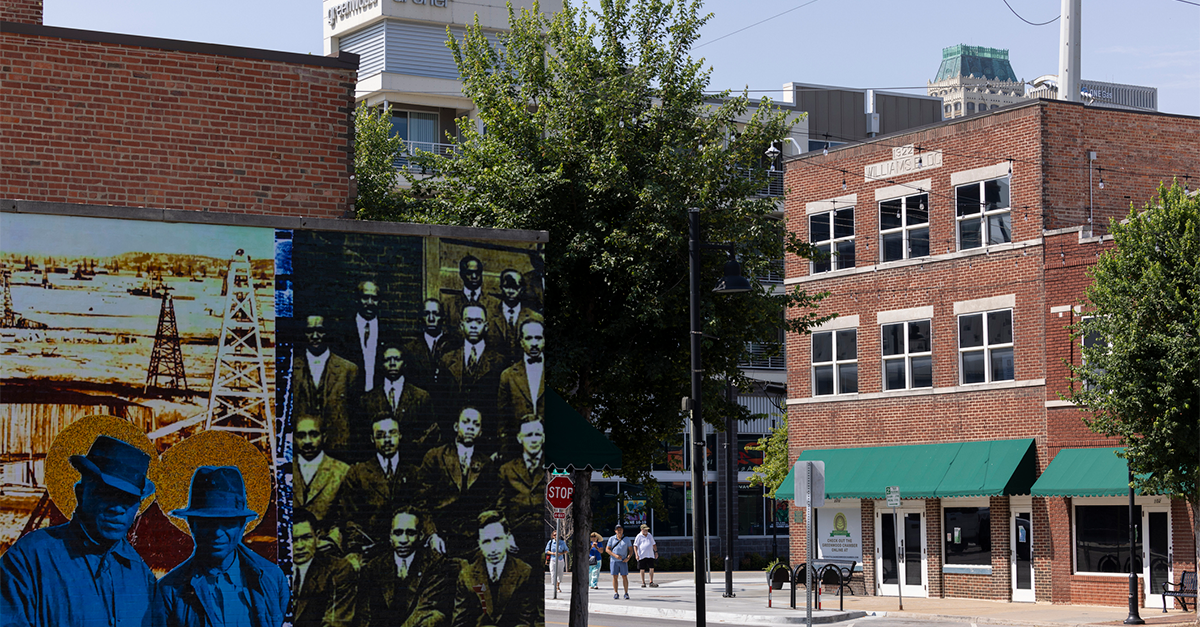
In North Tulsa, Oklahoma, generations of leadership, cultural wealth, and community advocacy have built a strong foundation for upward mobility. Yet many families in North Tulsa neighborhoods do not earn a living wage.
In response, a growing, cross-sector movement has been working to strengthen cradle-to-career pathways and economic opportunity, starting with North Tulsa and scaling up to Tulsa as a whole. Numerous local nonprofits, schools, faith leaders, small businesses, and residents are anchoring efforts to double the number of North Tulsa families earning a living wage by 2035.
Much of this work is grounded in StriveTogether’s Cradle-to-Career Framework, a national tool that provides progressive milestones across seven population-level outcomes. However, local leaders saw value in layering in the predictors and Mobility Metrics of the Urban Institute’s Upward Mobility Framework.
Representatives from ImpactTulsa and the George Kaiser Family Foundation joined the Urban Institute’s Mobility Action Learning Network (MALN) to create a unique framework grounded in local wisdom and better connect their existing upward mobility initiatives to help more residents reach long-term prosperity. This case study documents how the Tulsa Mobility Action Team (MAT) created their framework and offers insights for other local leaders looking to similarly combine their own frameworks with the Upward Mobility Framework.
THE GOAL
The Tulsa MAT identified three goals for connecting existing initiatives and strengthening opportunities for upward mobility across Tulsa:
- integrate the Upward Mobility Framework into the place-based initiatives in Tulsa already using the Cradle-to-Career Framework
- build a measurement framework with key performance indicators that could be used to measure and track success toward key upward mobility outcomes
- scale up neighborhood-level efforts and drive impact at the city and county levels
HOW THEY DID IT
Blending frameworks. To start, the Tulsa MAT compared the Mobility Metrics with the measurement indicators it was already tracking from StriveTogether’s Cradle-to-Career Framework. ImpactTulsa originally adopted this framework because of its strong evidence base showing the connection between achieving early-education milestones and later-in-life economic opportunity and success. Still, the team recognized that measuring indicators in health, the workforce, and neighborhoods—indicators included in the Upward Mobility Framework—would be critical for creating the conditions that support cradle-to-career success.
Engaging partners to select indicators and collect data. After the Tulsa MAT identified which parts of the two frameworks to integrate, work began to create a unified theory of action that could be implemented in the six-square-mile region one partner, InvestNorth, was focused on.
The MAT knew it would need to rely on community partners and local data sources when selecting indicators and collecting data, so it also worked to ensure the resulting framework was simple, concise, and communicable to people who may not have much data-collection expertise or experience. The MAT did this by conducting a series of engagement sessions on the data strategy and framework, consulting with key community-based partners to identify which indicators to focus on and supporting an inventory of community partners’ data that catalogued what data each partner had access to.
Implementing the model and scaling it to the city and county. After developing a framework for use in the InvestNorth neighborhoods, the Tulsa MAT began scaling its theory of change to leverage data-driven solutions, mobilize community resources, and track outcomes. Tulsa recently created the Mayor’s Office of Children, Youth, and Families, which is led by ImpactTulsa and will serve as a collaborative hub for improving outcomes for Tulsa’s children and families. Ultimately, it will be responsible for implementing programs, policies, and other initiatives to achieve its goal of placing 15,000 additional young people on a path to economic mobility by 2030. This hub will use the framework the MAT developed.
The data frameworks ImpactTulsa has created are also being applied across initiatives that serve all of Tulsa County. Partners across the county are implementing the cradle-to-career tracking framework in the My Brother’s Keeper Tulsa Initiative. In that work, which is organized across six action tables, the MAT’s framework is being used to inform strategy development and execution. These partners are also using Mobility Metrics to measure their progress on goals around education, employment, and safety from crime.
The data work being done in the InvestNorth region, the City of Tulsa, and Tulsa County and the measurement frameworks informing this work will be included in a “Tulsa Mobility Data Playbook,” which will be published in 2025 and will serve as an internal organizing document for coalition partners to better guide and align their work.
WHAT THEY LEARNED
The Upward Mobility Framework and other national frameworks are not mutually exclusive. The Upward Mobility Framework is interdisciplinary and spans policy areas to reflect that people don’t lead single-issue lives. In a single day, a person may interact with systems in their community in areas including health care, housing, work, and transportation. By weaving frameworks such as Cradle to Career with Upward Mobility, localities can take a more holistic approach to improving residents’ lives.
Start small, then scale up. Initially focusing on North Tulsa enabled the Tulsa MAT to build a practical theory of change. By starting small and finding an approach that works locally, the MAT is better positioned to scale up effective strategies to the city and county.
Have partners share accountability when possible. Given its success relying on community partners to collect and synthesize data about the community, the Tulsa MAT is taking this approach in developing its mobility playbook. This approach is ensuring community partners are engaging meaningfully in the delivery of the playbook while also improving the quality of the data collected. By relying on many partners to do this work, the MAT is ensuring a broad coalition is sharing accountability for helping all residents access upward mobility.